- Home
- Neal Stephenson
Mother Earth Mother Board Page 10
Mother Earth Mother Board Read online
Page 10
The answer has to do with slack control. And most of what is known about slack control is known by Cable & Wireless Marine. AT&T presumably knows about slack control too, but Cable & Wireless Marine has twice as many ships and dominates the deep-sea cable-laying industry. The Japanese can lay cable in shallow water and can repair it anywhere. But the reality is that when you want to slam a few thousand kilometers of state-of-the-art optical fiber across a major ocean, you call Cable & Wireless Marine, based in England. That is pretty much what FLAG did several years ago.
In which the Hacker Tourist treks to Land's end, the haunt of Druids, Pirates, and Telegraphers.
An idyllic hike to the tiny Cornish town of Porthcurno. More flagon hoisting at the Cable Station. Lord Kelvin's handiwork examined and explained. Early bits. The surveyors of the oceans in Chelmsford, and how computers play an essential part in their work. Alexander Graham Bell, the second Supreme Ninja Hacker Mage Lord, and his misguided analog detour. Legacy of Kelvin, Bell, and FLAG to the wired world.
50° 3.965' N, 5° 42.745 WLand's End, Cornwall, England
As anyone can see from a map of England, Cornwall is a good jumping-off place for cables across the Atlantic, whether they are laid westward to the Americas or southward to Spain or the Azores. A cable from this corner of the island needs to traverse neither the English Channel nor the Irish Sea, both of which are shallow and fraught with shipping. Cornwall also possesses the other necessary prerequisite of a cable landing site in that it is an ancient haunt of pirates and smugglers and is littered with ceremonial ruins left behind by shadowy occult figures. The cable station here is called Porthcurno.
Not knowing exactly where Porthcurno is (it is variously marked on maps, if marked at all), the hacker tourist can find it by starting at Land's End, which is unambiguously located (go to England; walk west until the land ends). He can then walk counterclockwise around the coastline. The old fractal question of "How long is the coastline of Great Britain" thus becomes more than a purely abstract exercise. The answer is that in Cornwall it is much longer than it looks, because the fractal dimension of the place is high - Cornwall is bumpy. All of the English people I talked to before getting here told me that the place was rugged and wild and beautiful, but I snidely assumed that they meant "by the standards of England." As it turns out, Cornwall is rugged and wild and beautiful even by the standards of, say, Northern California. In America we assume that any place where humans have lived for more than a generation has been pretty thoroughly screwed up, so it is startling to come to a place where 2,000-year-old ruins are all over the place and find that it is still virtually a wilderness.
From Land's End you can reach Porthcurno in two or three hours, depending on how much time you spend gawking at views, clambering up and down cliffs, exploring caves, and taking dips at small perfect beaches that can be found wedged into clefts in the rock.
Cables almost never land in industrial zones, first because such areas are heavily traveled and frequently dredged, second because of pure geography. Industry likes rivers, which bring currents, which are bad for cables. Cities like flat land. But flat land above the tide line implies a correspondingly gentle slope below the water, meaning that the cable will pass for a greater distance through the treacherous shallows. Three to thirty meters is the range of depth where most of the ocean dynamics are and where cable must be armored. But in wild places like Porthcurno or Lan Tao Island, rivers are few and small, and the land bursts almost vertically from the sea. The same geography, of course, favors pirates and smugglers.
On the other hand, what looks to a pirate like an accessible port of entry can be a remote refuge to a landlubber. Cornwall, like Wales, is one of the places where peculiar and unpopular Britishers have long gone to seek refuge - it was the last part of England to become English. And when Kublai Khan was storming China, the last Mongol emperor fled southward until he reached - you guessed it - Lan Tao Island, where he and his dynasty died.
< stone. the through down straight shaft a bore to have You?d chance. stand wouldn?t them bolted duct steel and rock, solid are cliffs The butterflies. bunnies, snails, of ecosystem Potter Beatrix with populated farmland inhabited sparsely into off leveling before meters 100 perhaps rising seas, heaving out up bolt Cliffs cable. land place no be seems there rugged so it?s that is note, immediately will tourist hacker as Cornwall, problem only>
But all becomes clear when you clamber over yet another headland and discover Porthcurno, a perfect beach of pale sand sloping gently out of clear turquoise water and giving way to a cozy valley that, a few miles inland, rises to the level of the inland plateau. To the hacker tourist, it comes as no surprise to learn that much of that valley has been owned by Cable & Wireless, or its predecessors, for more than a century. To anyone else, the only obvious hint that this place has anything to do with cables comes from the rusty yellow signs that stand above the beach proclaiming "Telephone Cable" as a feeble effort to dissuade mariners from using the bay for anchor practice.
It was here that the long-range submarine cable business, after any number of early-round knockdowns, finally dragged its bloody self up off the mat and really began to kick ass.
By the year 1870, Kelvin and others had finally worked the bugs out of the technology. A three-master anchored off this beach in that year and landed a cable that eventually ran to Lisbon, Gibraltar, Malta, Alexandria, Cairo, Suez, Aden (now part of Yemen), Bombay, over land to the east coast of India, then on to Penang, Malacca, Singapore, Batavia (later Jakarta), and finally to Darwin, Australia. It was Australia's first direct link to Great Britain and, hardly by coincidence, also connected every British outpost of importance in between. It was the spinal cord of the Empire.
The company that laid the first part of it was called the Falmouth, Gibraltar and Malta Telegraph Company, which is odd because the cable never went to Falmouth - a major port some 50 kilometers from Porthcurno. Enough anchors had hooked cables, even by that point, that "major port" and "submarine cable station" were seen to be incompatible, so the landing site was moved to Porthcurno.That was just the beginning: the company (later called the Eastern Cable Company, after all the segments between Porthcurno and Darwin merged) was every bit as conscious of the importance of redundancy as today's Internet architects - probably more so, given the unreliability of early cables. They ran another cable from Porthcurno to the Azores and then to Ascension Island, where it forked: one side headed to South America while the other went to Cape Town and then across the Indian Ocean. Subsequent transatlantic cables terminated at Porthcurno as well.
Many of the features that made Cornwall attractive to cable operators also made it a suitable place to conduct transatlantic radio experiments, and so in 1900 Guglielmo Marconi himself established a laboratory on Lizard Point, which is directly across the bay from Porthcurno, some 30 kilometers distant. Marconi had another station on the Isle of Wight, a few hundred kilometers to the east, and when he succeeded in sending messages between the two, he constructed a more powerful transmitter at the Lizard station and began trying to send messages to a receiver in Newfoundland. The competitive threat to the cable industry could hardly have been more obvious, and so the Eastern Telegraph Company raised a 60-meter mast above its Porthcurno site, hoisted an antenna, and began eavesdropping on Marconi's transmissions. A couple of decades later, after the Italian had worked the bugs out of the system, the government stepped in and arranged a merger between his company and the submarine cable companies to create a new, fully integrated communications monopoly called Cable & Wireless.
50° 2.602' N5° 39.054' WMuseum of Submarine Telegraphy, Porthcurno, Cornwall
On a sunny summer day, Porthcurno Beach was crowded with holiday makers. The vast majority of these were scantily clad and tended to face toward the sun and the sea. The fully clothed and heavily shod tourists with their backs to the water were the hacker tourists; they were headed for a tiny, windowless cement blockhouse, scarcely big enough to serve as a one-car gara
ge, planted at the apex of the beach. There was a sign on the wall identifying it as the Museum of Submarine Telegraphy and stating that it is open only on Wednesday and Friday.
This was appalling news. We arrived on a Monday morning, and our maniacal schedule would not brook a two-day wait. Stunned, heartbroken, we walked around the thing a couple of times, which occupied about 30 seconds. The lifeguard watched us uneasily. We admired the brand-new manhole cover set into the ground in front of the hut, stamped with the year '96, which strongly suggested a connection with FLAG. We wandered up the valley for a couple of hundred meters until it opened up into a parking lot for beach-goers, surrounded by older white masonry buildings. These were well-maintained but did not seem to be used for much. We peered at a couple of these and speculated (wrongly, as it turned out) that they were the landing station for FLAG.
Tantalizing hints were everywhere: the inevitable plethora of manholes, networked to one another by long straight strips of new pavement set into the parking lot and the road. Nearby, a small junkheap containing several lengths of what to the casual visitor might look like old, dirty pipe but which on closer examination proved to be hunks of discarded coaxial cable. But all the buildings were locked and empty, and no one was around.
Our journey seemed to have culminated in failure. We then noticed that one of the white buildings had a sign on the door identifying it as The Cable Station - Free House. The sign was adorned with a painting of a Victorian shore landing in progress - a line of small boats supporting a heavy cable being payed out from a sailing ship anchored in Porthcurno Bay.
After coming all this way, it seemed criminal not to have a drink in this pub. By hacker tourist standards, a manhole cover counts as a major attraction, and so it was almost surreal to have stumbled across a place that had seemingly been conceived and built specifically for us. Indeed, we were the only customers in the place. We admired the photographs and paintings on the walls, which all had something or other to do with cables. We made friends with Sally the Dog, chatted with the proprietress, grabbed a pint, and went out into the beer garden to drown our sorrows.
Somewhat later, we unburdened ourselves to the proprietress, who looked a bit startled to learn of our strange mission, and said, "Oh, the fellows who run the museum are inside just now."
Faster than a bit speeding down an optical fiber we were back inside the pub where we discovered half a dozen distinguished gentlemen sitting around a table, finishing up their lunches. One of them, a tall, handsome, craggy sort, apologized for having ink on his fingers. We made some feeble effort to explain the concept of Wired magazine (never easy), and they jumped up from their seats, pulled key chains out of their pockets, and took us across the parking lot, through the gate, and into the museum proper. We made friends with Minnie the Cable Dog and got the tour. Our primary guides were Ron Werngren (the gent with ink on his fingers, which I will explain in a minute) and John Worrall, who is the cheerful, energetic, talkative sort who seems to be an obligatory feature of any cable-related site.
All of these men are retired Cable & Wireless employees. They sketched in for us the history of this strange compound of white buildings. Like any old-time cable station, it housed the equipment for receiving and transmitting messages as well as lodgings and support services for the telegraphers who manned it. But in addition it served as the campus of a school where Cable & Wireless foreign service staff were trained, complete with dormitories, faculty housing, gymnasium, and dining hall.
The whole campus has been shut down since 1970. In recent years, though, the gentlemen we met in the pub, with the assistance of a local historical trust, have been building and operating the Museum of Submarine Telegraphy here. These men are of a generation that trained on the campus shortly after World War II, and between them they have lived and worked in just as many exotic places as the latter-day cable guys we met on Lan Tao Island: Buenos Aires, Ascension Island, Cyprus, Jordan, the West Indies, Saudi Arabia, Bahrain, Trinidad, Dubai.
Fortunately, the tiny hut above the beach is not the museum. It's just the place where the cables are terminated. FLAG and other modern cables bypass it and terminate in a modern station up at the head of the valley, so
all of the cables in this hut are old and out of service. They are labeled with the names of the cities where they terminate: Faial in the Azores, Brest in France, Bilbao in Spain, Gibraltar 1, Saint John's in Newfoundland, the Isles of Scilly, two cables to Carcavelos in Portugal, Vigo in Spain, Gibraltar 2 and 3. From this hut, the wires proceed up the valley a couple hundred meters to the cable station proper, which is encased in solid rock.
During World War II, the Porthcurno cable nexus was such a painfully obvious target for a Nazi attack that a detachment of Cornish miners were brought in to carve a big tunnel out of a rock hill that rises above the campus. This turned out to be so wet that it was necessary to then construct a house inside the tunnel, complete with pitched roof, gutters, and downspouts to carry away the eternal drizzle of groundwater. The strategically important parts of the cable station were moved inside. Porthcurno Bay and the Cable & Wireless campus were laced with additional defensive measures, like a fuel-filled pipe underneath the water to cremate incoming Huns.
Now the house in the tunnel is the home of the museum. It is sealed from the outside world by two blast doors, each of which consists of a foot-thick box welded together from inch-thick steel plate. The inner door has a gasket to keep out poison gas. Inside, the building is clean and almost cozy, and except for the lack of windows, one is not conscious of being underground.
Practically the first thing we saw upon entering was a fully functional Kelvin mirror galvanometer - the exquisitely sensitive detector that sent Wildman Whitehouse into ignominy, made the first transatlantic cable useful, and earned William Thomson his first major fortune. Most of its delicate innards are concealed within a metal case. The beam of light that reflects off its tiny twisting mirror shines against a long horizontal screen of paper, marked and numbered like a yardstick, extending about 10 inches on either side of a central zero point. The light forms a spot on this screen about the size and shape of a dime cut in half. It is so sensitive that merely touching the machine's case - grounding it - causes the spot of light to swing wildly to one end of the scale.
At Porthcurno this device was used for more than one purpose. One of the most important activities at a cable station is pinpointing the locations of faults, which is done by measuring the resistance in the cable. Since the resistance per unit of length is a known quantity, a precise measurement of resistance gives the distance to the fault. Measuring resistance was done by use of a device called a Wheatstone bridge. The museum has a beautiful one, built in a walnut box with big brass knobs for dialing in resistances. Use of the Wheatstone bridge relies on achieving a null current with the highest attainable level of precision, and for this purpose, no instrument on earth was better suited than the Kelvin mirror galvanometer. Locating a mid-ocean fault in a cable therefore was reduced to a problem of twiddling the dials on the Wheatstone bridge until the galvanometer's spot of light was centered on the zero mark.
The reason for the ink on Ron Werngren's fingers became evident when we moved to another room and beheld a genuine Kelvin siphon recorder, which he was in the process of debugging. This machine represented the first step in the removal of humans from the global communications loop that has culminated in the machine room at cable landing stations like Ninomiya.
After Kelvin's mirror galvanometer became standard equipment throughout the wired world, every message coming down the cables had to pass, briefly, through the minds of human operators such as the ones who were schooled at the Porthcurno campus. These were highly trained young men in slicked hair and starched collars, working in teams of two or three: one to watch the moving spot of light and divine the letters, a second to write them down, and, if the message were being relayed down another cable, a third to key it in again.
It was clear from the very
beginning that this was an error-prone process, and when the young men in the starched collars began getting into fistfights, it also became clear that it was a job full of stress. The stress derived from the fact that if the man watching the spot of light let his attention wander for one moment, information would be forever lost. What was needed was some mechanical way to make a record of the signals coming down the cable. But because of the weakness of these signals, this was no easy job.
Lord Kelvin, never one to rest on his laurels, solved the problem with the siphon recorder. For all its historical importance, and for all the money it made Kelvin, it is a flaky-looking piece of business. There is a reel of paper tape which is drawn steadily through the machine by a motor. Mounted above it is a small reservoir containing perhaps a tablespoon of ink. What looks like a gossamer strand emerges from the ink and bends around through some delicate metal fittings so that its other end caresses the surface of the moving tape. This strand is actually an extremely thin glass tube that siphons the ink from the reservoir onto the paper. The idea is that the current in the cable, by passing through an electromechanical device, will cause this tube to move slightly to one side or the other, just like the spot of light in the mirror galvanometer. But the current in the old cables was so feeble that even the infinitesimal contact point between the glass tube and the tape still induced too much friction, so Kelvin invented a remarkable kludge: he built a vibrator into the system that causes the glass tube to thrum like a guitar string so that its point of contact on the paper is always in slight motion.

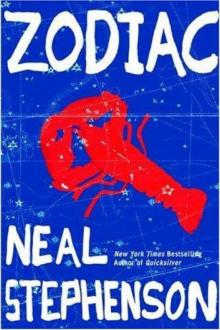 Zodiac: The Eco-Thriller
Zodiac: The Eco-Thriller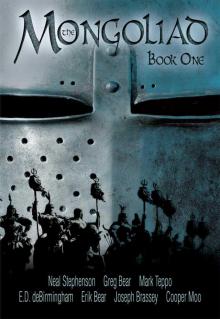 The Mongoliad: Book One
The Mongoliad: Book One Snow Crash
Snow Crash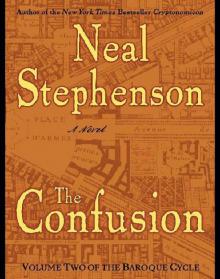 The Confusion: Volume Two of the Baroque Cycle
The Confusion: Volume Two of the Baroque Cycle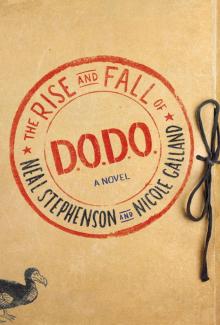 The Rise and Fall of D.O.D.O.
The Rise and Fall of D.O.D.O.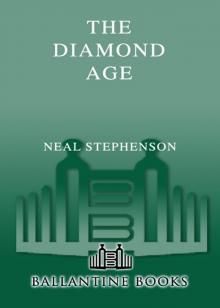 The Diamond Age: Or, a Young Lady's Illustrated Primer
The Diamond Age: Or, a Young Lady's Illustrated Primer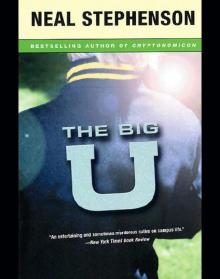 The Big U
The Big U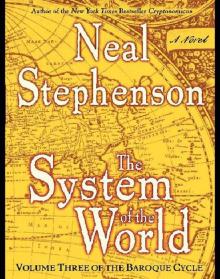 The System of the World: Volume Three of the Baroque Cycle
The System of the World: Volume Three of the Baroque Cycle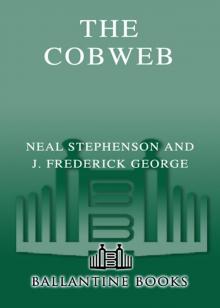 The Cobweb
The Cobweb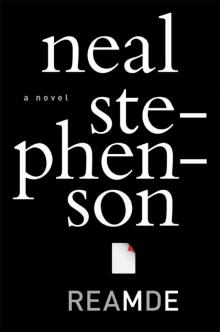 Reamde
Reamde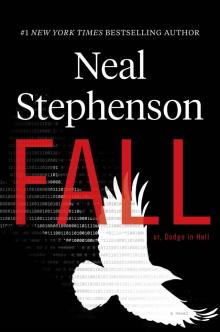 Fall; or, Dodge in Hell
Fall; or, Dodge in Hell Interface
Interface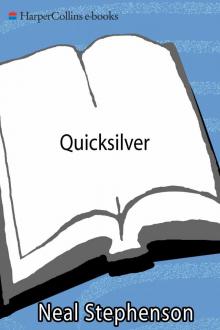 Quicksilver
Quicksilver The Mongoliad: Book Three
The Mongoliad: Book Three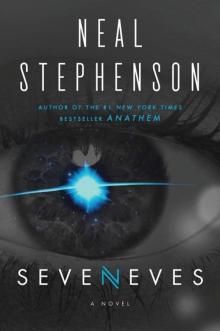 Seveneves
Seveneves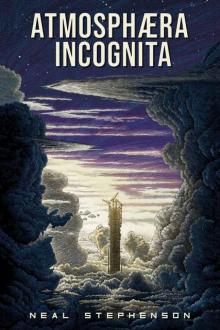 Atmosphæra Incognita
Atmosphæra Incognita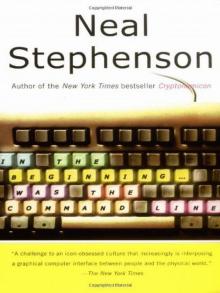 In the Beginning...Was the Command Line
In the Beginning...Was the Command Line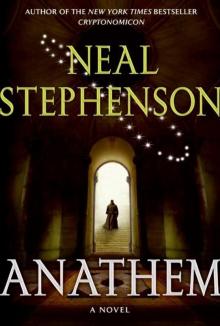 Anathem
Anathem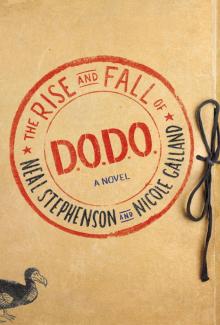 The Rise and Fall of D.O.D.O.: A Novel
The Rise and Fall of D.O.D.O.: A Novel The Mongoliad: Book Two
The Mongoliad: Book Two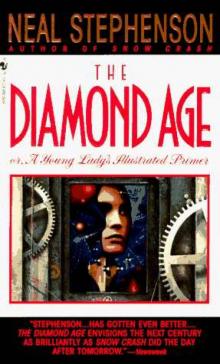 Diamond Age or a Young Lady's Illustrated Primer
Diamond Age or a Young Lady's Illustrated Primer THE System OF THE WORLD
THE System OF THE WORLD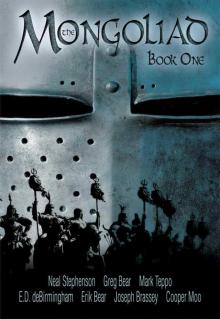 The Mongoliad: Book One tfs-1
The Mongoliad: Book One tfs-1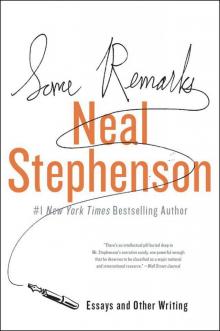 Some Remarks: Essays and Other Writing
Some Remarks: Essays and Other Writing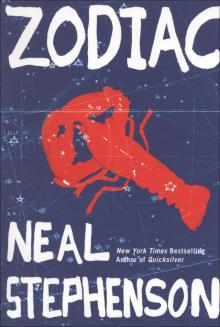 Zodiac
Zodiac Spew
Spew The Baroque Cycle: Quicksilver, the Confusion, and the System of the World
The Baroque Cycle: Quicksilver, the Confusion, and the System of the World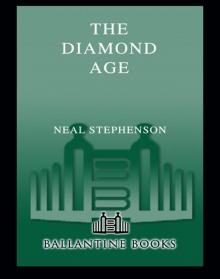 The Diamond Age
The Diamond Age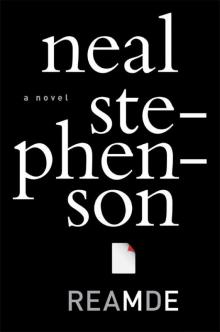 Reamde: A Novel
Reamde: A Novel In the Kingdom of Mao Bell
In the Kingdom of Mao Bell Mother Earth Mother Board
Mother Earth Mother Board Twelve Tomorrows - Visionary stories of the near future inspired by today's technologies
Twelve Tomorrows - Visionary stories of the near future inspired by today's technologies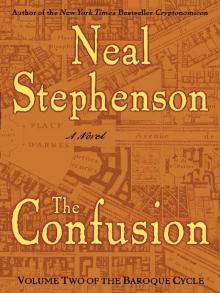 The Confusion
The Confusion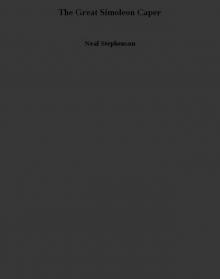 The Great Simoleon Caper
The Great Simoleon Caper The Mongoliad: Book Three tfs-3
The Mongoliad: Book Three tfs-3